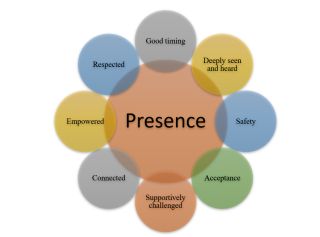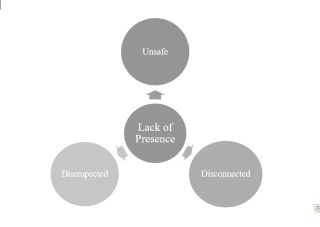Therapy
Presence in Therapy: Feeling Safe and Challenged to Grow
A study asked clients what they experience of therapist “presence.”
Updated September 3, 2024 Reviewed by Davia Sills
Key points
- A study found eight themes for what clients experience when their therapist was fully “present.”
- Themes included feeling “safe,” “deeply seen and heard,” and “supportively challenged” to change and grow.
- In a time of constant distraction, this study explores benefits of “being fully here now” in relationships.
- In a time valuing “safe spaces” and having “no filter,” study explores the yin/yang of present relationships
"Therapeutic presence lies at the heart of positive therapeutic relationships—receptively attuning to the client, oneself, and the relationship between, invites a sense of safety and a feeling of being seen and understood." —Shari Geller

We Believe “Presence” Is Important, and That We Dont Experience It Enough
We expect our therapist to be there; really be there. They won’t be distracted. They won’t “make it all about themselves.” They won’t get too “in their head” or encourage us to over-intellectualize.
They won’t stare at their smartwatch, yawn in our faces, or roll their eyes at us. They won’t float away into space or drift into a TikTok video or into sleep. They don’t come in hot with a rigid agenda, dominating and ignoring what we bring into the room. They won’t miss signs we are in distress.
We expect therapists to focus all their attention, emotional intelligence, training, creativity, curiosity, and ethical standards on us, our issues, goals, needs, strengths, and our experience in the moment.
My study showed highly present therapists tend to not shy away from allowing their clients to express intense emotion, do not prematurely push interpretations, or force clients to “reframe” difficult experiences into “positive” ones. They tend to not miss opportunities for appropriate or helpful self-disclosure or for appropriate expression of their own poignant emotion.
As Shari Geller writes, highly present therapists tend to be “with the client and for the client.” This is the spirit of presence. It’s not about rigidly forcing ourselves to not think about the past or the future while piercing the client’s soul with our intense gaze. It’s also not about always being nice, calm, and shying away from creating movement toward growth.
We know folks who are not present with us and don’t listen well. They interrupt. A lot. They make assumptions. Often. They assert their agendas on us.
We start to express ourselves, and they jerk the conversation away. They force a self-serving narrative about us. It makes them feel powerful or superior.
They see us only as either fuel or a threat to their ego. Some of them love the sound of their own voice more than getting to know who we really are. For some, these folks were their primary caretakers growing up. And it wounded them. Deeply.
Others mean well but are addicted to their watches, phones, and the dramas of their own experience. They may love and want the best for us. Some were raised by these folks—a mixed bag of presence and the lack of presence.
The best way to avoid judging someone else’s lack of presence is to take a good look at our own. As a therapist, I’m convinced that presence is essential for a deep therapeutic relationship, and a deep therapeutic relationship is the best burnout prevention.
What, then, do we really experience when we go to a therapist who is physically, emotionally, energetically, and cognitively attuned and deeply with us and for us?

New Study on the Client Experience of Therapist Presence
I recently conducted a yet-to-be-published study exploring this question.
The study showed eight themes for the client’s experience of “therapeutic presence” and three themes for the client’s experience of the lack of therapeutic presence.
I utilized a small sample of six participants. Qualitative research often aims to go in-depth with a small number of participants and cannot make claims of statistical generalizability. Nonetheless, qualitative research findings can provide food for thought for therapists, clients, and researchers and motivate further quantitative and qualitative research.
I would not be writing this post if the findings did not deeply resonate with me as a therapy client and an experienced therapist and if seasoned professionals in the field I respect were not interested in these findings. I worked hard to check my own biases throughout the research.
I used a research methodology called reflexive thematic analysis to determine themes in what participants said about their experience and to question my decisions. I audio-recorded 90-minute interviews with six clients in psychotherapy (not my own clients).
I asked questions such as: “What was your experience of your therapist like in your last session? Please give details.” I followed up with: “Please describe any instances where your therapist was really in tune with what you were experiencing in the moment,” “Please describe any instances where your therapist was really in the moment with you,” and “Please describe any instances where your therapist seemed distracted.” These three follow-up questions come from a psychological scale, the Therapist Presence Inventory (TPI), created by Shari Geller and Leslie Greenberg.
All participants found their current therapists mostly highly present. Five out of six discussed the lack of presence from previous therapists. Worth noting: In the rare instances where participants found their current therapist less present, they felt compassion for their therapist. These moments made the client feel more connected to their therapist. This is worth therapists pausing to reflect on.
I asked follow-up questions to get at clients’ emotions, physical sensations, and specific images or metaphors in their minds regarding what their therapist did behaviorally in these moments of presence or lack of presence, as well as any meaning the participant attached to these moments. I needed to determine when participants spoke of therapist behavior regarding the presence or the lack of presence, and I also needed to hear the client’s experience of those moments in therapy.
I kept a reflexive journal questioning my own biases. Myself and a second reviewer (a Ph.D. student) listened to the recordings, read the transcripts, and coded the data for moments where the client appeared to speak to the therapists’ presence or lack of presence. We came up with 40-plus instances where participants spoke of their experience of therapist presence and a similar number for instances of lack of therapist presence. We narrowed down these codes into themes.

Nuances of Presence in Therapy That Are Worth Exploring Further
This study may help shed light on the dynamic experience of clients in therapy, which may enhance our understanding of healing relationships. It has been proposed that presence may be a factor that helps other core factors in therapy (such as the therapeutic relationship, empathy, collaboration, and repairing ruptures) function more effectively (Geller & Greenberg, 2022; Schneider, 2015).
I cover topics such as the difference between meditation and “presence” in therapy, nuances of the client and therapist’s experience of presence, including cultural considerations, potential downsides to presence, potential benefits to therapist authenticity and “congruence” regarding their own moments of lack of presence in therapy, presence and creativity, the potential benefits of “daydreaming” in therapy, the differences between external-focused presence and internal-focused presence, and more aspects of this fascinating (to me) topic of presence in the therapy room (and in life).
To find a therapist, visit the Psychology Today Therapy Directory.
References
Bradshaw, C.C. (2024). The client experience of therapeutic presence (unpublished doctoral dissertation). Saybrook University.
Geller, S.M., Greenberg, L.S. (2022). Therapeutic presence: A mindful approach to effective therapy 2nd edition. American Psychological Association.
Geller, S.M., Greenberg, L.S. (2010). Therapeutic presence inventories (TPI)- client and therapist versions. Retrieved from https://www.sharigeller.ca/_images/pdfs/Therapeutic_Presence_Inventory_…
Geller, S.M., Porges, S.W. (2014). Therapeutic presence: Neurophysiological mechanisms mediating feeling safe in therapeutic relationships. Journal of Psychotherapy Integration, 24(3), 178-192.
Schneider, K.J. (2015). Presence: The core contextual factor in effective psychotherapy. Existential Analysis(2)2: 304-312.
Schneider, K.J., Krug, O.T. (2017). Existential-humanistic therapy 2nd edition. American Psychological Association.




